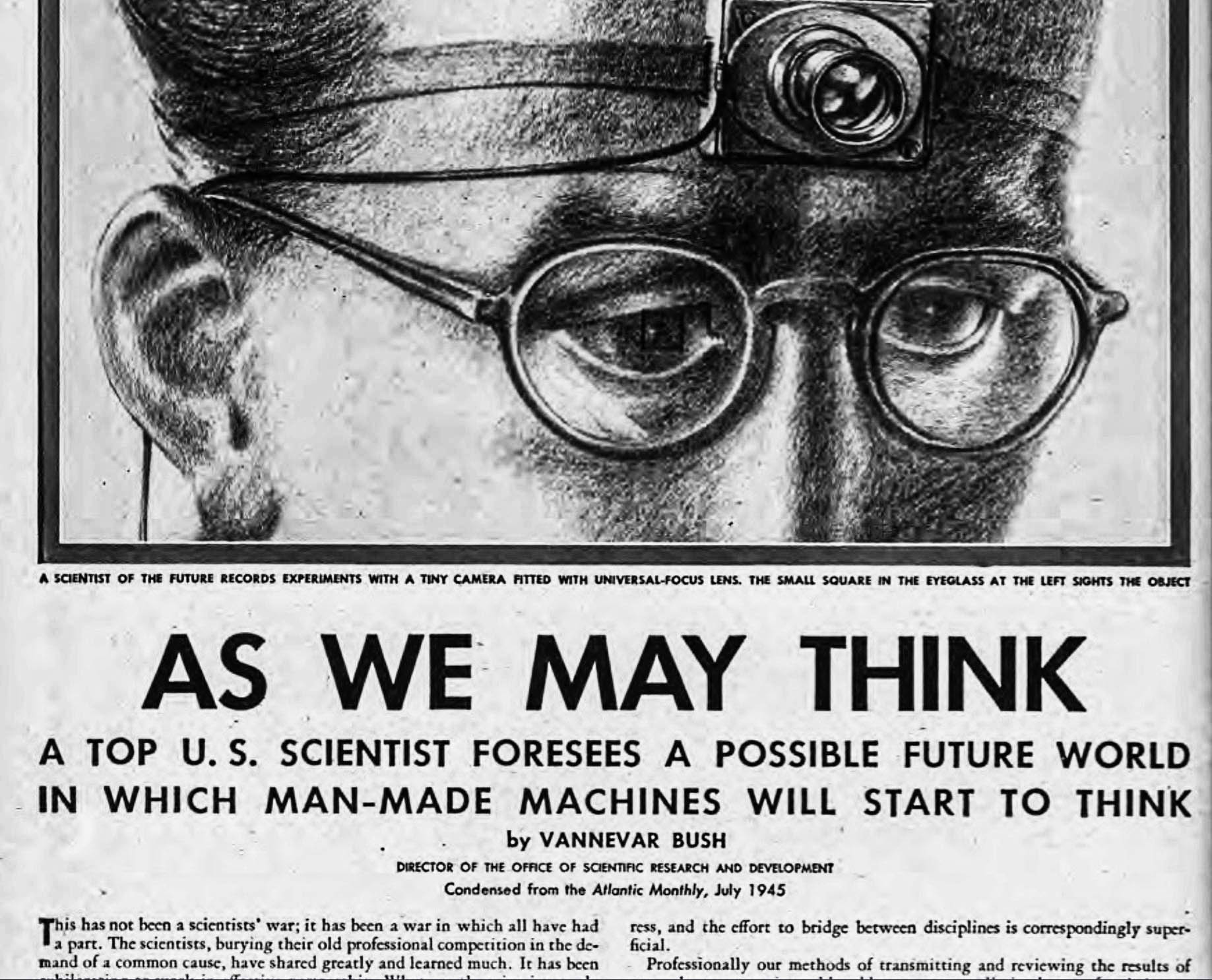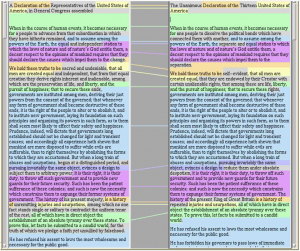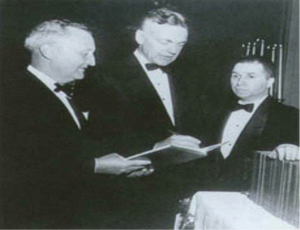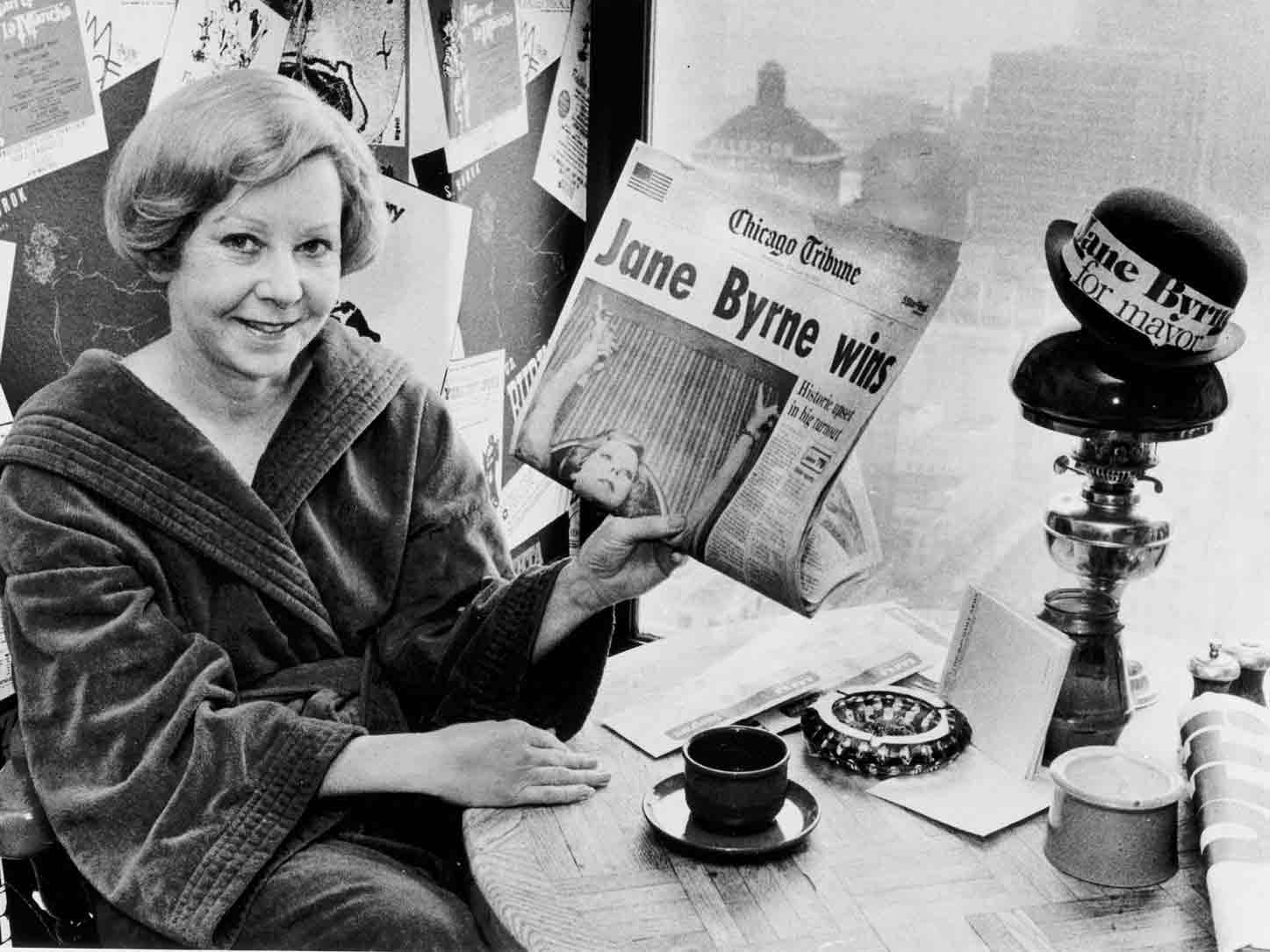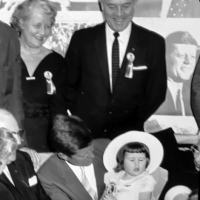An Unlikely First Mover
Who would have guessed that at the end of the 20th Century it would be a company founded in Scotland in 1768 that would invent a key part of the mechanics that would let people intuitively navigate the electronic flood of text, sound and images soon to drench the planet from the internet?
In 1989, 221 years after the company’s founding in Edinburgh during the Scottish Enlightenment, Chicago-based Encyclopaedia Britannica, Inc., publisher of its eponymous Encyclopædia Britannica reference work, had not only solved this puzzle for the first time, it was issued a patent for it. While it may be incongruous that a legacy reference print publisher would be the party to make the discovery, this is exactly what happened.
Normal patents on inventions have a revenue producing life of 20 years. The patents Britannica filed for in 1989 were issued by the U.S. Patent and Trademark Office in 1993, but they were unusual in that they never earned a nickel. Indeed, after years of litigation in multiple court venues, they were finally found to have been improperly issued by the U.S. Court of Appeals for the Federal Circuit in 2011 because of a technical error in the original filing papers. The technical defects meant that the courts never got to a detailed ruling on whether then commonplace GPS navigation systems infringed the patents covering Britannica’s invention. Though Encyclopaedia Britannica never benefited financially from the extraordinary human/machine interface it had been the first to build, it had reason to be proud of its fundamental achievement. Its revolutionary human/machine interface provided seamless navigational paths into and through complex digital databases of mixed media including, text, graphics, maps, videos and audio elements that even a nine-year old could master.
Britannica’s landmark invention has partly to do with the evolution of the personal computer in the mid-1980s. But it also has to do with a small group of encyclopedists who had been struggling for many years before to define what an electronic encyclopedia would look like. The culmination of their work happened to coincide with the coming of age of the personal computer in the nascent consumer market.
This fortuitous combination produced a remarkable cultural breakthrough. It meant that for the first time, children, as well as adults, could easily and quickly access and navigate complex and media-rich stores of digital information. It also created a plumbing roadmap for the software design that in later years would prove essential in making user friendly such diverse applications as automobile GPS navigation systems and websites.
Hypertext and the Search for the Machine/Human Interface
Four pioneers in the development of computer interfaces stand out: Vannevar Bush, Ted Nelson, Douglas Engelbart, and Alan Kay. Each of these four individuals made exceptional contributions to the developing field how humans interact with machines and each helped set the stage for Encyclopaedia Britannica’s unique invention in the 1980s. Two of these four individuals, Bush and Kay, even directly applied their thinking to the problem of building an electronic encyclopedia.
Vannevar Bush
The scientist with the most penetrating early vision of the machine’s potential role in helping us easily access the growing storehouse of human knowledge was Vannevar Bush. After he received a joint doctorate in electrical engineering from the Massachusetts Institute of Technology and Harvard in 1916, Bush showed a bent for military applications by inventing a submarine detection device during World War I. Then in the 1920s at MIT, he began to design and build analog computers. These early machines used voltage variances to reflect different numeric values.
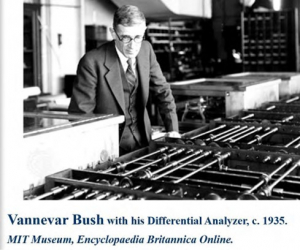
These machines were the precursors to today’s binary language, digital computers that use zeros and ones to represent data. In 1928, Bush was issued a pioneering patent for one of his computers and by 1935 his Rockefeller Differential Analyzer was the most powerful computer of its day. It was quickly put to the task of solving problems associated with the development of long-distance power lines. Then, in World War II, it was turned to the task of producing artillery ballistics tables to assist the military.
At the beginning of World War II, Bush made recommendations to President Franklin Roosevelt about how to organize scientific research to keep the military abreast of new technologies. Then, during the war, Bush headed the federal government’s Office of Scientific Research and Development. It has been said that radar (from the acronym for “radio detection and ranging”) won the war, and the atomic bomb ended it. Bush and his Office had played a crucial role in both developments.
Towards the end of the war, Bush gave considerable thought to the potential application of computers to peacetime requirements and their likely evolution in the post-war era. He came to believe computers could play an important peacetime role in managing the increasing store of humanity’s accumulated knowledge.
The Atlantic Monthly’s 1945 “As We May Think” Article
In a now landmark article for the Atlantic Monthly published in July 1945, entitled “As We May Think,” Bush laid out a vision of a world in which computers would be central to our social and business life. The article remains, to this day, stunning in the accuracy of its perceptions regarding the likely evolution of computing. In an introduction describing the thrust of Bush’s article, the Atlantic Monthly’s Editor wrote, “Now, says Doctor Bush, instruments are at hand which, if properly developed, will give men access to and command over the inherited knowledge of the ages.” No small step for Mankind that.
In the article, Bush looked at recent advances, such as the cathode ray tube, dry photography and microphotography and pondered how logical extensions of these technologies might be applied to create a future miniaturized Encyclopædia Britannica:
“The Encyclopædia Britannica could be reduced to the volume of a matchbox. A library of a million volumes could be compressed into one end of a desk. If the human race has produced since the invention of movable type a total record, in the form of magazines, newspapers, books, tracts, advertising
blurbs, correspondence, having a volume corresponding to a billion books, the whole affair, assembled and compressed, could be lugged off in a moving van.”
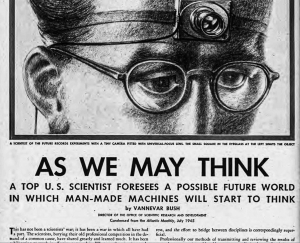
December 1945 Life Magazine Reprint of Atlantic Monthly Article Bush’s “Memex” and Today’s Personal Computer
Although Bush thought in terms of microfilm rather than magnetic drives, optical discs or silicon wafers for data storage, he conjured up a likely playback machine for a high-capacity storage medium that closely resembles the personal computer of today. Bush called it a Memex and described it this way:
“Consider a future device for individual use, which is a sort of mechanized private file and library. It needs a name, and, to coin one at random, ‘memex’, will do. A memex is a device in which an individual stores all his books, records, and communications, and which is mechanized so that it may be consulted with exceeding speed and flexibility. It is an enlarged intimate
supplement to his memory. … On the top are slanting translucent screens, on which material can be projected for convenient reading. There is a keyboard, and sets of buttons and levers. Otherwise, it looks like an ordinary desk. In one end is the stored material . . . Wholly new forms of encyclopedias will appear ready made with a mesh of associative trails running through them, ready to be dropped into the memex and there amplified.”
Bush did a prescient job describing in 1945 his idea of what a personal computer of the future might look like. This is particularly true given the required reliance on vacuum tubes for the computers in that era. Vacuum tubes were a great limitation for the computers of the time.
Though the transistor was invented in 1947 by physicists at Bell Telephone Laboratories, the shift from slow, heat producing vacuum tubes that often burned out, to cooler, more powerful and reliable transistors did not unfold overnight.
For instance, when the March 1949 issue of Popular Mechanics surveyed the then state of the art ENIAC computer (from “Electronic Numerical Integrator And Computer”), the potential impact of the transistor, let alone the microprocessor chip, was entirely missing: “Where a calculator on the ENIAC is equipped with 18,000 vacuum tubes and weighs 30 tons, computers in the future may have only 1,000 vacuum tubes and perhaps weigh 1.5 tons.”
Hypertext Envisioned
Another element of the information management challenge that Bush understood was the fact that quickly finding information through data compression and advanced displays didn’t solve the need to move with ease from one type of pertinent information to different, but related, information. He recognized that there remained a need for a human/machine interface that more realistically mirrored the way people thought.
And, so, in one final burst of creative insight, Vannevar Bush dreamed up what we call today “hypertext” or “hyperlinking.” That’s the highlighted text or interactive graphic on a computer screen that, when clicked upon with a mouse, takes the user to related information stored in a different location.
Bush saw that static indices were an imperfect way to search for and access information and what was needed was a more direct way of moving from one thought to a related one. He understood that a major limitation in quickly accessing desired information was the absence of ways to associatively access that information. In short, he saw the need for a random access mechanism that would also provide quick connections to related information in different locations– hyperlinks as we now refer to them.
“Mere compression, of course, is not enough; one needs not only to make and store a record but also be able to consult it. Our ineptitude in getting at the record is largely caused by the artificiality of systems of indexing. When data of any sort are placed in storage, they are filed alphabetically or numerically, and information is found (when it is) by tracing it down from subclass to subclass.
It can be in only one place, unless duplicates are used; one has to have rules as to which path will locate it, and the rules are cumbersome. Having found one item, moreover, one has to emerge from the system and re- enter on a new path.
The human mind does not work that way. It operates by association. With one item in its grasp, it snaps instantly to the next that is suggested by the association of thoughts, in accordance with some intricate web of trails carried by the cells of the brain. Selection by association, rather than indexing, may yet be mechanized.”
Hypertext Pursued
Ted Nelson

Ted Nelson
While Ted Nelson’s software concept named Project Xanadu, was unable to be reduced to practice notwithstanding decades of fitful development, researchers today look back on Nelson’s ideas about hypertext as influential in how people thought about computer interface concepts and the potentially revolutionary nature of hyperlinks.
His parents were Hollywood royalty. Father Ralph Nelson was the directed the 1963 movie Lilies of the Field that led to Sidney Poitier winning the first Academy Award for Best Actor. His mother was actress Celeste Holm who was nominated for her performance in the 1950 movie All About Eve.
With a BA in philosophy from Swarthmore College, a small liberal arts school in Pennsylvania founded by Quakers, Nelson started graduate school in sociology in 1959 at the University of Chicago. Moving on to Harvard, he received his MA in 1962.
It was at Harvard that he began to work on a “writing system” that would let people store what they had written, change it, and print it out. His concept included being able to see alterations in a side by side format that would also retain the train of changes. As Project Xanadu evolved through the decades of the unsuccessful effort to produce a useful and commercial software product, hints of what could be in store were evident, but never made workable.
Xanadu Showing Changing Drafts of the Declaration of Independence
Nelson used the term “hypertext” in several papers he published in 1965. Though the code for Xanadu could never be written that would make dream come true, the search went on to find a workable way to make usefully connect non-sequential text. Nelson published his ideas in a paper submitted to the Association for Computing Machinery in 1965. He further developed them in his books Computer Lib/Dream Machines (1974) and Literary Machines (1981).
In the 1950s and 1960s, the utility seen in the foresight and musings of Bush and Nelson was still far away given the state of computer development at the time. This was the era of big iron, as the IBM and other mainframe computers were known. Even with their growing power and scale, they could not yet manage the facile integration of images with text, let alone coupling them with sound and video. While continuing to develop, the speed and processing power of big iron’s central processing units remained in its infancy. On the storage end of things. magnetic drum memory devices had come to market in 1950. They functioned by storing information on the outside of a rotating cylinder coated with ferromagnetic material. This was circled by read and write heads that remained in a fixed position.
Douglas Engelbart
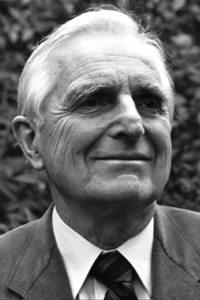
Douglas Engelbart
It was Douglas Engelbart who was able to take Bush’s concept of hypertext to a more concrete level with a stunning demonstration in 1968 of what the future held.
Engelbart, was born in Portland, Oregon, in 1925, he died in 2013. Ted Nelson gave an impassioned eulogy at his memorial service. You get a good view of his charismatic personality as he rails against the forces he believes held himself and Engelbart back during their lives.
Engelbart had been drafted into the Navy in World War II, where he had served as a radar technician. Perhaps his familiarity with cathode ray tubes prepared him for the role he was to play later in the evolution of the visually-centric human/computer interface. While awaiting discharge from the Army in the Philippines at the end of the War, he had read Bush’s article, “As We May Think.” As it turned out, Bush’s precepts remained at the center of Engelbart’s later career in computer science. When he got home, he pursued an education in electrical engineering, receiving a B.S. from Oregon State University in 1948 and a Ph.D. from the University of California, Berkeley, in 1955.
After 1957, when the Soviet Union launched Sputnik, the first earth orbiting satellite, the U.S. government, through the Department of Defense’s Advanced Research Projects’ Agency (ARPA), and the Air Force Office of Scientific Research made funds available to further research in computer science. Engelbart had joined a group at the Stanford Research Institute (SRI) in Menlo Park, California and in 1962, under a contract with the Air Force Office of Scientific Research, wrote a seminal paper building on Vannevar Bush’s earlier concepts. In the paper Augmenting Human Intellect: A Conceptual Framework, he sketched out the basis of his advanced thinking on the development of a human/machine interface.
The paper cites Bush’s Memex as important is thinking about next steps not in building a better computer, but in building a better way for humans to interact with the machines so as to leverage the unique powers of human intellect so that it can be efficiently applied to analyze the vastly increasing body of mankind’s knowledge. Engelbart writes in the paper:
The Memex adds a factor of speed and convenience to ordinary filing-system (symbol-structuring) processes that would encourage new methods of work by the user, and it also adds speed and convenience for processes not generally used before. Making it easy to establish and follow the associative trails makes practical a new symbol-structuring process whose use can make a significant difference in the concept structuring and basic methods of work. It is also probable that clever usage of associative-trail manipulation can augment the human’s process structuring and executing capabilities so that he could successfully make use of even more powerful symbol-structure manipulation processes utilizing the Memex capabilities. An example of this general sort of thing was given by Bush, where he points out that the file index can be called to view at the push of a button, which implicitly provides greater capability to work within more sophisticated and complex indexing systems.
Later in the 1960s, Engelbart and his colleagues at SRI, particularly William K. English and John F. Rulifson, created what they called the “Online System (NLS).” They also developed a graphical user interface (GUI) (pronounced “gooey”) to facilitate operating it.
In the 1960s, in corporate America, universities and the government, “big iron” IBM mainframe computers ruled. Input into computers was still done largely through punch cards. Output was typically paper as well. Standard computer output to a visual device was still a print out. These machines were not for ordinary folk, as they were almost entirely devoted to a triad of commercial, scientific and number crunching users. It was quite a departure for Engelbart and his band of software engineers to focus on a highly visual interface, one that even lay people might master. Their unique approach to GUIs and computing led to the development of basic tools such as the mouse, hypertext linking and word- processing in a windows environment.
On December 9, 1968, Engelbart demonstrated his NLS at the Fall Joint Computer Conference in San Francisco. Those who witnessed his use of a keyboard, display screen and mouse knew they were present at an unusual moment. It’s not surprising that footage from this event was later put on display at the Smithsonian Museum’s exhibit on the Information Age. The combination of the mouse as a tool to interact with the display screen was a giant home run for those present and for the generations of computer users to follow.
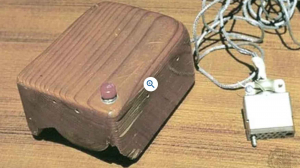
Engelbart invented the computer mouse in 1963–64
Alan Kay
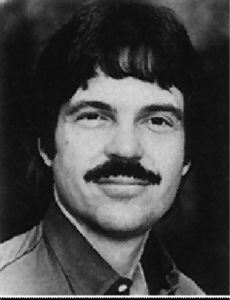
Alan Kay
ARPA funding of SRI’s work dried up in the early 1970s. When Engelbart’s SRI activity center closed in 1977, a number of its computer researchers moved on to Xerox Corporation’s Palo Alto Research Center (PARC) to carry on their work on human/computer interfaces.
PARC researchers, including notably Alan Kay, continued to focus on marrying graphics and animation to computer systems. They also thought about simpler interfaces that even children could interact with. Pertinent to Britannica, Kay would also focus later on the likely nature of an electronic encyclopedia.
Kay’s early education had had a lot to do with computers. After a tour in the Air Force working on IBM computers, Kay had enrolled at the University of Colorado, receiving his undergraduate degree in mathematics and molecular biology in 1966. In 1969, he received his PhD in computer science from the University of Utah. His thesis was about graphical object orientation. After teaching two years at the Stanford Artificial Intelligence Laboratory, Kay moved on to PARC, where he focused on bitmap displays, windowing, and the point-click-and-drag user interface.
When Steve Jobs and his colleagues at Apple visited PARC in 1979, they saw the future of computing in what Kay and his colleagues had been working on. Apple’s later unique graphical user interface reflected PARC’s cutting edge approach to interface design. Not surprisingly, Kay later served Apple directly as a research Fellow, before serving in a similar capacity for The Walt Disney Company, and, beginning in November 2002, for Hewlett-Packard.
Through the work of Nelson, Engelbart, Kay and many others, Bush’s early ideas about advances in computing technology evolved and, by the early 1980s, computing machines had begun to enter the consumer mainstream.
However, the prevailing operating system displays of the day were still arid and text centric. There were no high resolution or color displays. Also missing was the much larger local storage capacity required to play the game of dynamic knowledge management.
As a result, dreaming up a theoretical machine with an interface for ordinary folk and filled with programs rich in data and loaded with computer-based hyperlinks remained much easier to do than actually building one. Many such as Ted Nelson and Alan Kay had begun to think the interface side of things through. Kay in particular gave extended thought to construction of a complex encyclopedic database.
However, the stage had been set for the big breakthrough: computers built for the consumer market. Louisiana Senator Huey Long’s depression era campaign promise of “a chicken in every pot” became “a computer in every home” for Apple and IBM in the 1980s. Time magazine made the IBM Personal Computer “Machine of the Year” in 1981, and the next year Steve Jobs of Apple made the cover. This was testament to the fact that the computer finally was moving out of its prior confines of big government, big business, and big universities and into the home.
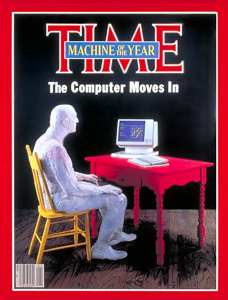
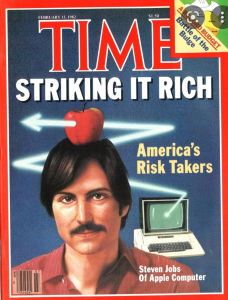
The Proper Study of Mankind
Although a print publisher throughout its long life, Encyclopaedia Britannica had been keeping abreast of these developments closely. In Britannica had just put the finishing touches on its massive rewriting of its Encyclopaedia Britannica encyclopedia by adding when the first CD-ROM (for Compact Disc-Read Only Memory) storage discs first came out, Britannica. In 1985, Britannica had just put the finishing touches on its multi-decade, massive rewriting of its entire 1928 14th Edition. The 15th Edition had originally been published in 1974 in a 30-volume set. The icing on the cake was the addition in 1985 of three additional volumes: a two-volume index to the 15the Edition, and a one-volume guide to the knowledge it contained called the Propaedia.
The redesign of the Encyclopaedia Britannica in the several decades before the Compton’s launch was a critical precursor to EB’s invention. Then, in 1988 and 1989, the Compton’s Multimedia Encyclopedia development project gave birth to the Britannica multimedia search system patent. Finally, with the first patent issuing in 2002, and continuation patent in subsequent years, the stage was set for Britannica to exploit its achievement more fully.
English poet Alexander Pope began the second epistle of his 1732 work An Essay on Man with the couplet, “Know then thyself, presume not God to scan; The proper study of Mankind is Man.” His reference to our genome-embedded drive to understand ourselves and catalog our knowledge is symbolized and given tangible shape by the encyclopedic form. The long, continuous history of the encyclopedia
in our civilization is evidence that our collective need for self-examination is hard- wired into our brains. Thus, the presence of a reference publisher at the center of a critical human/machine interface development in the 1980s was not entirely an accident. It stemmed in part from the very nature of encyclopedias in modern society. The word “encyclopedia” comes from the Greek words enkyklios, meaning general, and paideia, meaning education The effort to create a system of knowledge or circle of learning in the form of an “encyclopedia” spanning humankind’s knowledge has been with us for over 2,000 years, although it hasn’t always been called this. Speusippus, who died in 339 B.C., recorded his uncle Plato’s thinking on natural history, mathematics and philosophy. Speusippus also apparently attempted to record detailed descriptions of different species of plants and animals.
However, it was Denis Diderot’s Encyclopedie ou Dictionnarie raisonne des Sciences, des Arts, a et des Metiers, published in 1751 in Paris, that first popularized the use of the term encyclopedia to describe works containing a broad compendium of knowledge. Shortly thereafter, in 1768, the first edition of the Encyclopædia Britannica, the oldest and most comprehensive English-language encyclopedia, was published in Edinburgh, Scotland.
The Encyclopaedia Britannica 1st Edition
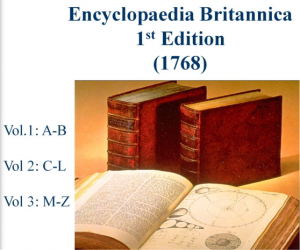
The three-volume first edition of the Encyclopædia Britannica paid homage to its classical roots in two conspicuous ways. One was a departure from the conventional spelling of encyclopedia. The use of the æ ligature preserved an ancient bequest of Greek and Roman scribes used to denote diphthongal pronunciation. Even by 1768 this device had fallen out of use except in the most rarefied of contexts. The other nod to antiquity was the Latinate title itself. It could easily have been called the British Encyclopedia, since Latin had ceased to be the lingua franca of the educated. In the 238 years since that first edition, Britannica’s stewards have continually changed everything else about the work, but they have always left its unusual title untouched.
The current 15th Edition was first published in 1974. Although there are regular revisions published, readers typically tend to keep their sets up to date by annually buying yearbooks that review recent developments. For the digitally inclined, online revisions to the encyclopedic corpus are done a number of times a year.
The Encyclopedist’s Art
In the twentieth century, encyclopedists have not been the only people to worry about how to facilitate access to an ever-growing sum of knowledge. The problem arising from the information explosion of modern times was also noticed by those who helped create it. In particular, the scientists and mathematicians who had created whole new disciplines of knowledge, such as atomic physics and computing machines, had also begun to think about how to increase efficient access by their colleagues and lay people to growing domains of information. 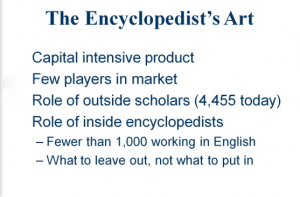 Since the mission of an encyclopedia is to encompass in an abbreviated and accessible form all of our knowledge about everything, the editorial investments needed to create encyclopedias have always been substantial. As a result, the number of encyclopedias has always been relatively few. Also, while there are several thousand distinguished outside contributors asked to write articles for an encyclopedia such as the Britannica (4,455 currently), there is a much smaller number of career encyclopedists charged with the actual design and creation of the work and its ongoing revision.
Since the mission of an encyclopedia is to encompass in an abbreviated and accessible form all of our knowledge about everything, the editorial investments needed to create encyclopedias have always been substantial. As a result, the number of encyclopedias has always been relatively few. Also, while there are several thousand distinguished outside contributors asked to write articles for an encyclopedia such as the Britannica (4,455 currently), there is a much smaller number of career encyclopedists charged with the actual design and creation of the work and its ongoing revision.
In the modern era, encyclopedists around the world working continuously in the English language have numbered in the hundreds rather than the thousands. And for over two centuries, the encyclopedists at Britannica have remained the most skilled and respected of their breed.
The task of an encyclopedist is an odd one. There are not many of these folks around, and the few there are around tend to spend their days in single-minded thought on how best to organize a brief, narrative summary (44 million words in the case of Encyclopædia Britannica) of our cumulative understandings of history, art, literature, science, religion, philosophy, and culture.
The encyclopedist’s art obviously lies in what to leave out, not what to put in.
Architects of the 15th Edition
William Benton, Publisher of EB
Robert Hutchins, University of Chicago President
Mortimer Adler, Philosopher
Charles Van Doren, EB Editorial Vice President
William Benton, Robert Hutchins & Mortimer Adler
The Publisher, The University President & The Philosopher
William Benton
Paralleling this whole development of the computer, there had been several decades of thinking by encyclopedists at Encyclopædia Britannica about the proper structure of a modern encyclopedia and how it might be conjoined with an appropriate human/machine interface adapted to the electronic age.
The 14th Edition of the Encyclopædia Britannica had been published in 1929, when the company was owned by Sears Roebuck. That same year William Benton founded the Benton and Bowles advertising agency in New York City. The agency prospered with the growth of network radio and its own innovations in the development of national advertising. Among other things, Benton & Bowles is credited with inventing the radio soap opera, which it used as a vehicle to sell its clients’ products.
Benton, later a vice president at The University of Chicago, used the proceeds from his sale of Benton & Bowles to acquire Britannica in 1943, after Sears failed at gifting the company to the University.
Robert Hutchins
Benton had been recruited to the University of Chicago in 1937 by his fellow student in the Yale College Class of 1924, then Chicago’s president, Robert Maynard Hutchins. Hutchins was one of the 20th Century’s most prominent intellects and educators. A true wunderkind, Hutchins had been named dean of the Yale Law School at the age of 28. He was only 30 at the time of his appointment as Chicago’s president in 1929.
The University’s trustees said famously as they turned down the gift Sears offered that the University was in the business of education, not the business of business. Bill Benton knew a good commercial opportunity when he saw it, however, and he seized both the moment and the company.
When Benton purchased Britannica, he agreed to pay the University a three percent royalty on U.S. encyclopedia sales in return for the editorial advice of its faculty. Not long thereafter, Benton appointed Hutchins chairman of Britannica’s board of editors. The University of Chicago’s connection to Encyclopædia Britannica lasted more than five decades. Thanks to the simpatico relationship of Benton and Hutchins, it brought the University’s endowment more than $200 million in that time.
15th Edition of the Encyclopaedia Britannica

In 1974, after an investment of more than $33 million, the 30-volume, 44 million word 15th Edition of Encyclopaedia Britannica was published. The event made the front page of the New York Times. A standalone two-volume index was added to the set as part of a major revision published in 1985.
Mortimer Adler
Mortimer J. Adler, a precocious student (and later critic) of philosopher John Dewey at Columbia University, had also been attracted to the University of Chicago in the 1930s. Hutchins had found appointments for him in philosophy and psychology and at The University of Chicago Law School.
Adler was an evangelist for a broad, liberal education and a strident critic of the disciplinary specialization just then coming to fruition at American universities. His and Hutchins’s impassioned arguments for an undergraduate curriculum based on the classic texts of Western civilization touched off years of stimulating, though acrimonious, debate at the University in the 1930s. Adler’s belief in exposing undergraduates to the classics fell in with Hutchins’ view that, “What the nation needs is more educated B.A.’s and fewer ignorant PhD’s.” Wags on the Midway soon were quoted reciting, “There is no God but Adler, and Hutchins is his Prophet.” Students also were heard singing an old New Year’s standard with a new refrain, “Should auld Aquinas be forgot.”
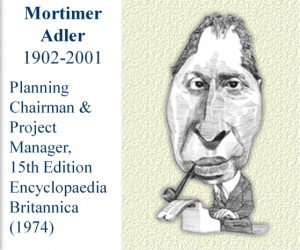
Adler later helped Hutchins complete editorial work on Britannica’s unique 54- volume canon of Western intellectual history, Great Books of the Western World. The set was published in 1952, the same year Adler left The University of Chicago. Notwithstanding its intellectual gravitas (from Homer, Aristotle and Aquinas to Freud), Britannica sold “Benton’s Folly” to ordinary Americans with great success.
By the early 1960s, the 14th Edition of Encyclopædia Britannica was showing its age. Benton, by this time, had also been an Assistant Secretary of State (he thought up the Voice of America), and a United States Senator (a Democrat from Connecticut and the first to denounce Senator Joe McCarthy).
When Benton was assembling his editorial team to prepare the groundwork for the 15th Edition, he found Adler in San Francisco, where he was finishing his two- volume work, The Idea of Freedom (1958-61). Hutchins, who had retired to California to head the Fund for the Republic think tank, established with help from the Ford Foundation. The Fund had helped finance Adler’s Institute for Philosophical Research in San Francisco.
In December 1962, as Adler celebrated his 60th birthday, his Institute was going nowhere, his marriage had failed, and he was in debt. Thus, he was in a receptive mood when William Benton reached out, “Come back to Chicago, Mortimer, and help me make a new and greater Encyclopædia Britannica. I’ll not only pay you a princely salary and fund the Institute, but I also support a series of Benton Lectures at The University of Chicago that can be the first step towards a new career for you—and an education for them.”
The Propaedia
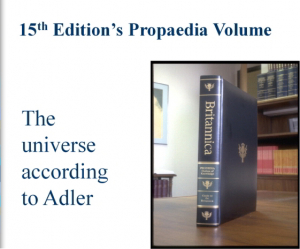
Charles Van Doren
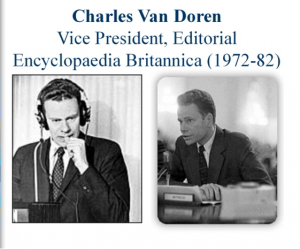
1962 was also a watershed year for Adler’s young friend and acolyte Charles Van Doren. In that year, Van Doren had received a suspended sentence following his conviction in New York State for perjury in the investigation into the fixed television game shows of the late 1950s.
As a sign that he was looking to the future, Van Doren published a scholarly article, “The Idea of an Encyclopedia,” in The American Behavioral Scientist that same year. In the article, Van Doren argued that American encyclopedias should no longer be mere compilations of facts (a criticism of the 14th Edition). He said they should educate, as well as inform. He also argued against encyclopedias that classified information in artificial pigeonholes reflecting university politics, and spoke in favor of celebrating the natural interrelatedness of man’s knowledge:
“It takes a brave man to master more than one discipline nowadays; bravery is not totally absent from our society, and so heroes can be found. But the man who attempts to find the principals which underlie two or more disciplines is considered not brave, but mad or subversive. Those whom graduate schools have put asunder, let no man join together!”
Van Doren’s article on encyclopedic form was influential enough to be selected for inclusion along with Vannevar Bush’s 1945 Atlantic Monthly essay, in the 1967 compilation, The Growth of Knowledge: Readings on Organization and Retrieval of Information. This book also took note of the theoretical work being done in automated text retrieval by Gerald Salton of the Department of Computer Science at Cornell.
When Adler moved back to Chicago to join Britannica in 1962, it is not surprising that he quickly found a place for the would-be encyclopedist Van Doren. Van Doren was a son of Adler’s old Columbia University teaching colleague and friend, poet Mark Van Doren, and Adler had known him since birth. As Charles Van Doren put it when he spoke at a 2001 memorial service following Adler’s death at age 98:
“And then there came the time when I fell down, face down in the mud, and he picked me up, brushed me off and gave me a job. It was the best kind of job: As he described it, one you would do anyway if you did not need the money. First we worked together making books for Encyclopædia Britannica. Then I, and many others, helped him to design and edit the greatest encyclopedia the world has ever seen.”
Reinventing the Encyclopedia in Electronic Form
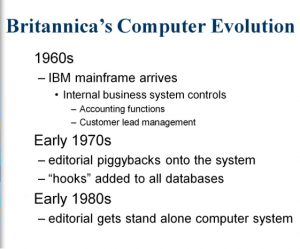
In 1981, Britannica’s now retired Editor, Warren Preece, published “Notes Towards a New Encyclopedia.” In this article Preece described the coming electronic encyclopedia.
As one of the architects of the 15th Edition, Preece was intimately familiar with the dense tapestry of cross references that connected related pieces of information spread throughout the Micropaedia, Macropaedia, and Propaedia, the three parts of the encyclopedia. He, more than most, was in a position to ponder the way in which the electronic publishing future might affect a corpus of this nature, and he explored the contours of these possibilities in his article.
Not only did Preece write that his newly envisaged encyclopedia would have an electronic version, but he also saw what Bush had not been in a position to see: optical laser-disc technology would be the likely storage medium for encyclopedic data. Preece also noted that with over 300,000 home computers then in private use in the U.S., online query privileges for up-to-date encyclopedic information was another possible direction for the encyclopedia of the future to take.
He also was attuned to certain competitive advantages an electronic encyclopedia would have over the book: it could hold more, be searched faster, and be updated more frequently.
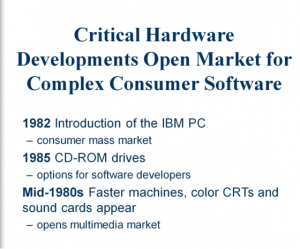
At Britannica, Van Doren was already leading the charge into Preece’s Brave New World. In May 1980, he had circulated to his colleagues a new agreement between Britannica and Mead Data Central. The four-year agreement called for the full text of the Encyclopædia Britannica to be put online as part of the Lexis-Nexis service. Mead was to pay Britannica up to 25% of Mead’s revenues from encyclopedia subscriptions. While being careful to discourage copyright infringement by not permitting subscribers to print articles from the encyclopedia, Britannica had now committed itself to an electronic future in more than a symbolic way.
Solving the PC Data Storage Problem
Britannica editor Warren Preece had been able to foresee the possibility of an optical disc encyclopedia because of breakthrough engineering developments that had taken place in Europe and Japan. Klass Compaan, a physicist with Philips research, based in The Netherlands, had conceived of the compact disc in 1969 and, with Piet Kramer, had produced the first color videodisc prototype in 1972. Philips then worked with Sony to develop a smaller compact disc standard for just storing audio signals.
The audio compact disc that emerged was made with a polycarbonate substrate, molded with pits that permitted a laser beam to read timing and tracking data. The so-called Red Book format of the compact disc was released in Japan and Europe in 1982, and in the U.S. the following year. A derivative format, designed to hold multimedia information and be played back on a computer was given the unwieldy name Compact Disc-Read Only Memory, CD-ROM for short. This was launched into the nascent personal computer market in 1985, several years after the first prototypes had been shown.
Grolier Publishing quickly put a text-only encyclopedia on a videodisc and also a CD-ROM in 1985. Most early CD-ROMs published were specialized compendia designed for commercial, not consumer, use. 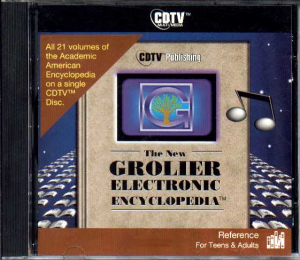 Navigation was accomplished through rules-based Boolean text string searches. Discs with sound, pictures, video and animation, although supported by the CD-ROM format, were not available.
Navigation was accomplished through rules-based Boolean text string searches. Discs with sound, pictures, video and animation, although supported by the CD-ROM format, were not available.
Microsoft believed that for sales of its operating system to grow at an exponential rate, software developers needed to be encouraged to use the new CD-ROM storage media to create compelling software for consumers. The assumption was that this would drive consumers to regard PCs in the home not just as gaming facilitators, but as a requirement for their children’s education. To this end, Microsoft showed off a CD-ROM multi-media encyclopedia demonstration disc at a CD-ROM developer’s
conference it held in 1986. The dozen five-page articles on the demonstration disc contained text, graphics, sound, a motion sequence and animation.
Compton’s Multimedia Encyclopedia Prime Movers:
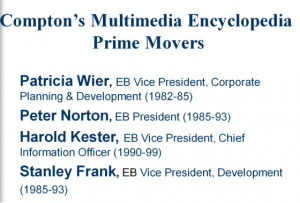
Patricia Wier, The MIT Media Lab and Alan Kay
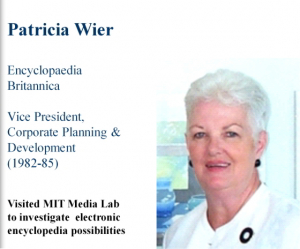
Britannica had first acquired a large mainframe computer in the 1960s. It had primarily been used to manage the company’s direct mail and installment sales activities, though it also did the usual accounting applications and managed the payroll and accounts receivable functions. In 1971, Britannica hired Patricia A. Wier to help manage computer systems and programming operations. Wier had been lured away from a computer management position at Playboy Magazine’s Chicago headquarters. A quick study, Wier was promoted to head Britannica’s computer operations within the same year.
Wier was determined to broaden the use of computers within the company, and before long Wier helped graft the in-house editorial system onto Britannica’s existing mainframe computer. This system was used to help produce the massive 15th Edition. It was not until the early 1980s, however, that Britannica moved to a stand- alone mainframe computer completely dedicated to editorial operations. At that time, all editorial and production work was put online, including page-makeup and indexing.
It was at this juncture that Wier was promoted to vice president of corporate planning and development. She was charged with developing or acquiring new products that would see Britannica into the future, particularly bearing in mind the new computer technologies that were coming to the fore. Soon she and editorial vice president Charles Van Doren began calling on various leading lights in the field of computer development to get ideas about the directions Britannica electronic products might take. Because Wier wanted to explore at a sophisticated level how the computer developments of the future might be put to use by a reference publisher such as Britannica, she traveled to the Massachusetts Institute of Technology.
MIT was then, as it is today, at the cutting edge of important computer developments. The people that she engaged at MIT included “artificial intelligence” guru Marvin Minsky at the MIT Media Lab. Minsky introduced her to a former student of his, Danny Hillis, by then at the supercomputer start up Thinking Machines. Both were intrigued with how computer technology might be applied to such an enormous and fascinating database as the Encyclopædia Britannica. Of particular interest to everyone Wier met was the dense indexing within the set that already existed, interconnecting as it did all parts of the database.
Wier recalls that when she met with Minsky at his home in Brookline, Massachusetts and entered the large casual room where their meeting was to take place, three grand pianos scattered around the room sounded the opening chords of Beethoven’s Fifth Symphony as the door opened. Minsky had other gadgets like this in his home, all reflecting his never-ending fascination with technology and its uses, both playful and serious. Grand pianos seemed the order of the day among these leading east coast technologists.
When Minsky and Wier visited the home of the Sheryl Handler, a co- founder with MIT graduate Danny Hillis of Thinking Machines, a supercomputer manufacturer. Minsky sat down at her new Bösendorfer grand piano and expertly indulged his passion for magnificent music machines. 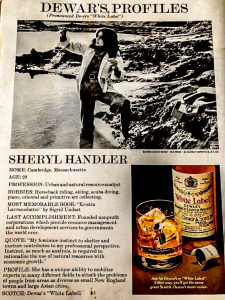 Though all Wier’s Boston-based interlocutors were singular, none could fully compete with one of Handler’s achievements. She had appeared in a Dewars Scotch Whiskey advertising profile next to the quote, “My feminine instinct to shelter and nurture contributes to my professional perspectives.”
Though all Wier’s Boston-based interlocutors were singular, none could fully compete with one of Handler’s achievements. She had appeared in a Dewars Scotch Whiskey advertising profile next to the quote, “My feminine instinct to shelter and nurture contributes to my professional perspectives.”
Wier also met briefly at this time with Nicholas Negroponte, director of the Lab. Wier and others were curious about how to use what was then called artificial intelligence to permit the recovery of pertinent electronic data in a more sophisticated manner than through key word searching alone.
During this period, Wier and Britannica USA president Peter Norton also met with Alan Kay to discuss how rapidly developing computer technology might impact an electronic encyclopedia.
At the time Kay was working with Atari to produce electronic games, but Wier recollects that he was fascinated with the content of Encyclopædia Britannica and came to Chicago to visit Britannica’s corporate headquarters to learn more.
His sneakers and jeans, while standard mode of attire for Silicon Valley, caused heads to turn and eyebrows to raise at then straight-laced Britannica Centre. The requirements for more formal business garb at Britannica and other offices in downtown Chicago didn’t disappear until well into the ’90s. Wier and Kay, who had his own associations with the MIT Media Lab, also brainstormed about someday using encyclopedic information in voice-controlled graphics on walls in the home.
In 1983, with her research complete, Wier proposed to Britannica’s board of directors that it embark on the creation of an interactive electronic encyclopedia. Wier, who retired in 1993 as president of Britannica USA, got an answer akin to the one given by the University of Chicago’s directors when they turned down Sears’ Britannica gift. Wier remembers she was told in no uncertain terms, « We sell books! »
At Atari’s Sunnyvale Research Laboratory, Kay consulted the next year on an encyclopedia research project sponsored by Atari, the National Science Foundation, and Hewlett-Packard. Joining Kay as a consultant on the prototype Encyclopedia Project was Charles Van Doren, recently retired from Encyclopædia Britannica.
Peter Norton Takes Britannica into the Software Business
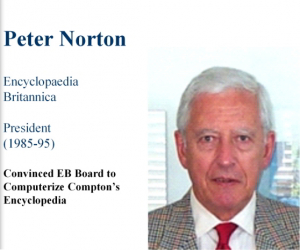
Although not willing to follow Wier’s advice in 1983, Britannica’s board of directors did believe the company needed to get closer to the emerging personal computer market. That year, Encyclopædia Britannica Educational Corporation, which I later served as president, published a dozen floppy disk educational titles that it had
acquired for the Apple II platform. Soon Britannica decided to directly acquire its own software development capability. In 1985, it purchased Design Wear, EduWear, and Blue Chip, three small San Francisco-based software publishers also selling 5¼ inch floppy magnetic disk products.
With the introduction that year of the CD-ROM format, Britannica also began to think about how it might exploit this new medium. The question was not a simple one. With its vast storage capacity, the Encyclopædia Britannica itself was thought to be too massive to be put on a CD-ROM, even with minimal indexing and a text- only format. Also, the entire business model of the company was still built on selling its flagship, multi-volume print work at a purchase price of $1,200 and up, depending on the binding. The direct selling sales culture that prevailed at Britannica was no more receptive to the idea of an inexpensive, electronic alternative to the print set than it had been when Patricia Wier first made her recommendation.
In 1987, Britannica’s management, led by Englishman Peter Norton, hit on a solution. This time the plan was not seen as a threat to the sales force and it was endorsed by the board of directors. Instead of putting the Encyclopædia Britannica
on a CD-ROM, Britannica would become a leader in the newly developing software publishing industry by building a multi-media CD-ROM version of its student- oriented Compton’s Encyclopedia. At the time, the Compton’s print set was given away free as a premium to purchasers of the more expensive Encyclopædia Britannica print set.
Harold Kester, SmarTrieve and Compton’s Multimedia Encyclopedia
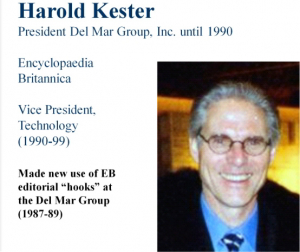
After further analyzing the potential market for such a work, Stanley Frank, in charge of development by then, decided in 1988 to partner in its development with Education Systems Corporation of San Diego, California. ESC had expertise in software development through building networked educational products for the school market. ESC chose as its text search engine subcontractor, the Del Mar Group. Del Mar was a Solana Beach, California venture capital startup, with funding from Japanese computer maker Fujitsu.
Del Mar’s chief scientist, Harold Kester, had already been building CD-ROM reference publications, though not for the consumer market. Importantly, Kester was also a student of the work of Gerald Salton at Cornell University. Salton had been doing pioneering research into the mathematical principles underlying automatic text retrieval. As Greg Bestik, ESC’s head of development, Kester, and Britannica’s editors and software engineers got together to plan the design of what became Compton’s Multimedia Encyclopedia, they had one clear instruction from Britannica’s management: Britannica was ready to invest millions of dollars in the product’s development, but it must publish a revolutionary offering that would be a clear breakthrough in simplifying a user’s interaction with computers.
This would not be a text-only product like Groliers. The depth of Britannica’s vast holdings of reference media in film, pictures, animations, and sound would all be made available for close integration with the Compton’s encyclopedic text. Kester’s great contribution to this enterprise was to produce a natural language search engine that would help permit the prototypical nine-year-old to easily search the entire database for articles of interest. Instead of expecting a nine-year-old to master the intricacies of Boolean logic in constructing search queries (“Sky” AND “Blue”), Britannica’s nine year old needed only to type in the search box “Why is the sky blue?” That would be enough to for Del Mar’s “SmarTriev” search engine to take the user to the answer.
The Del Mar Group had begun selling PC based software for interactive kiosks in bookstores shortly after its organization in 1984. That led it into becoming one of the first CD-ROM publishers the next year. It published the fifth CD-ROM in the United States in 1985, a prototype of a product intended for bookstores that would permit consumers to interact with a database and be guided to titles of interest. Its SmarTriev search system was licensed to other CD-ROM developers, and, in 1986, Del Mar briefly had the largest installed base of CD-ROMs in the country. Informed by Gerald Salton’s earlier work, SmarTriev’s natural language search and retrieval system went far beyond the usual database search engines of its day.
Duly impressed, Britannica purchased SmarTriev and hired Kester as soon as the networked version of Compton’s product was complete.
When Britannica and ESC signed their co-development agreement in April 1988, the Del Mar Group dived in to help with the preparation of the design document. This was completed in July 1988. It set forth in elaborate detail the architecture of the Compton’s Multimedia Encyclopedia that would be published in the new CD- ROM format in the fall of the following year. The design document was very much a collaborative one. ESC had talented computer programmers and educational experts in San Diego and Austin, Texas sites. Harold Kester and his search engine group worked from Solana Beach, California, and the Britannica editors and software experts were in Chicago and San Francisco.
During development, between 40 and 80 individuals were active at any given time in working to bring the design document to life as a fully functioning product. This would be no prototype or demonstration vehicle for show and tell at a futurists’ conference. They were about inventing and building the real thing. Those on the design team with a background in educational psychology were sensitive to the fact that children learned in different ways. They pressed home the desirability of having different ways, both textual and graphical, for users to access the same information.
Stanley Frank
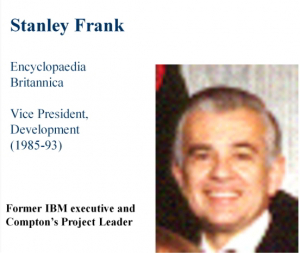 Thus, from the beginning, the novel idea of developing an architecture based upon multiple search paths to related information was central to the product. Also fundamental to the design were reciprocal hyperlinks between related data contained in other search paths. With a product that was easy to use and that could easily facilitate different styles of learning, the group felt they were building a blockbuster, both for the network market within schools, as well as for the stand-alone consumer market.
Thus, from the beginning, the novel idea of developing an architecture based upon multiple search paths to related information was central to the product. Also fundamental to the design were reciprocal hyperlinks between related data contained in other search paths. With a product that was easy to use and that could easily facilitate different styles of learning, the group felt they were building a blockbuster, both for the network market within schools, as well as for the stand-alone consumer market.
This combination of ESC’s computer networking programing expertise together with Britannica’s skilled encyclopedists was a unique combination for the times. And building an electronic database that went beyond text to include sound, animation, video and maps, could never have been accomplished without the millions of dollars that was invested by Britannica both before and during the development of the Compton’s Multimedia Encyclopedia product. This unusual combination of human resources, coupled with a subset of Britannica’s rich editorial content, turned out to be the secret sauce needed to invent and build the software needed to bring a highly complex digital work to life.
If anyone doubts the difficulty of pulling this task off, for a parallel they need only look at the decades long and costly failure of Ted Nelson’s Xanadu effort to actually produce a useful product this ambitious that actually worked.
Britannica released a network version for schools of Compton’s Multimedia Encyclopedia in fall 1989 at a press conference at the New York Academy of Science. The news media was out in force, recognizing the product as potentially noteworthy. Britannica’s executive vice president, Dr. Stanley Frank, who had overseen the development process, demonstrated the Compton’s CD-ROM for a national television audience through a live presentation that reached the nation on ABC’s Good Morning America television show.
The consumer version of Compton’s CD-ROM was published shortly after in March 1990 at a price of $895. Compton’s Multimedia Encyclopedia, on a single CD-ROM disc, contained an amazing 13 million words, 7,000 images and numerous movies, animations and sound clips.
Compton’s Multimedia Encyclopedia Makes a Splash
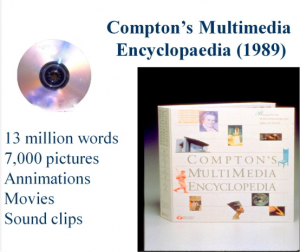
The media again took notice. Said Newsweek of the breakthrough computer interface:
“Computers aren’t just smart typewriters and zippy number crunchers anymore. . . Yet, so far hype has outstripped hopes in the growing collection of multimedia programs. Like dazzling Hollywood flops, most have turned out to be long on technology, but short on substance. Until Compton’s. . . Just getting that much information on a disc is impressive enough. Yet the beauty of Compton’s is in the links – everything is woven together so the user can quickly move between related bits of information. Thanks to ingenious design, the program is so simple that, literally, a child can use it. . . Hit a difficult word? A click will bring up the definition – and if your PC has sound capability, the machine will even pronounce it for you. Whetted appetites: A staff of 80 writers, editors, designers and programmers worked for two years to bring the product to market.”
The effect on people experiencing Compton’s for the first time could be stunning. Former Vice President Walter Mondale, like his political patron saint Hubert Humphrey before him, served on the Encyclopædia Britannica board of directors. Shortly after the Compton’s product was released, Mondale had an opportunity to see the newly developed product with other directors at a retail store. He read with interest his own biographical entry reflecting his service as Vice President. After looking with less interest at the text of the entry on Richard Nixon, he got up from the keyboard and turned to leave. His escort quickly clicked on the audio icon in the Nixon article. When the computer speakers boomed Nixon’s disembodied voice (“Well, I’m not a crook!”), Mondale turned around, frozen in amazement. He was obviously not prepared for this Nixon redux.
Computer hardware manufacturers quickly saw Compton’s could help sell their boxes to consumers. Tandy Corporation immediately struck a deal with Britannica to sell its new multimedia PC for $4,500, with the $895 Compton’s disc thrown in for free. IBM, not wishing to be left behind, quickly gave Britannica a million dollars towards EB’s continued development of the product, making sure it was adapted to IBM’s newly planned multimedia computer entry.



